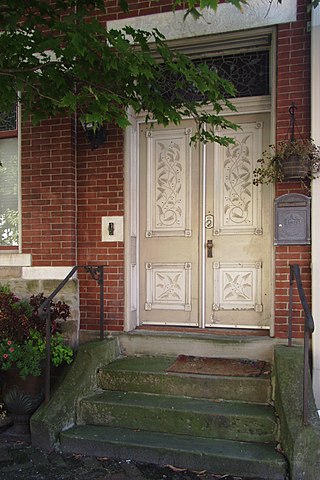
Shadows highlight the unusually intricate brickwork on the Schiller Glocke Gesang und Turn Verein, South Side.

This is certainly one of old Pa Pitt’s most esoteric subjects. In rowhouse neighborhoods, there are often tunnel-like passages through to the rear yard of a house, with the upper storeys built over the passage. These outdoor passages are called “breezeways” in Pittsburgh; in other cities they may be called gangways or alleys. Sometimes the passage runs through one house; sometimes it is shared by two houses. We see examples of both in this little collection.









Edwards Way is the very edge of the South Side Flats. The greenery-covered wall on the left is the stone retaining wall below the railroad that separates the Flats from the Slopes. Of course this tiny narrow space is nevertheless too valuable to leave unbuilt, so the free side of the alley is lined with typical South Side alley houses.

The last block of Jane Street on the South Side Flats (as opposed to the resumed Jane Street on the Slopes side of the tracks) feels delightfully private, lined on the north side with charming Second Empire rowhouses facing an old herringbone-pattern brick sidewalk. The colors of the houses and flowers shine out all the brighter in the gloom of a rainy day.

The curiously angular Gothic of this 1881 church might have pleased a congregation that wanted a building that looked like a church, but not one that looked too medieval. Like many other churches in the most crowded Pittsburgh neighborhoods (including several on the South Side), it adapts to its tiny lot by placing the sanctuary on the second floor, leaving the ground floor for Sunday-school rooms and social halls.

The famous Victorian front doors of the South Side are featured on posters and in picture books on coffee tables all over western Pennsylvania. There is an endless variety to the woodwork on these South Side rowhouses. Old Pa Pitt was out walking on the South Side and decided to concentrate on doors: here is the collection he made in just half an hour’s stroll. Click on any picture to enlarge it.











Many of these doorways have decorative stained-glass transoms over the door, often with the address worked into the glass:


Of course, no collection of South Side front doors would be complete without a Kool Vent awning on an alley house:


Carson Street is the commercial spine of the South Side, but occasionally we run across a house left over from the time before Carson was almost exclusively commercial. Most of them have small offices on the ground floors now, but they retain their domestic external appearance. This house strikes Father Pitt as a halfway point between Second Empire and Italianate styles in local rowhouses; it’s notable for its prickly decorative ironwork on the roof.